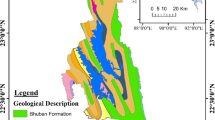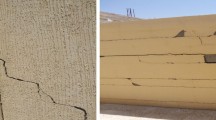Abstract
This study examines the stability of an embankment used in stone quarry reclamation built of local natural soil mixed with stone dust. Stone dust is a fine-grained and low-strength material, whereas soil is coarser with higher strength. Test results show that the shear strength and maximum dry unit weight of the mixed material increase with a decrease in the stone dust. After reviewing various domestic and international standards for slope stability, this study suggests a three-grade slope stability rating system (“unstable,” “requires attention” and “stable”) for embankments built of soil mixed with stone dust. A series of slope stability analysis aims to define stable heights, slope angles and mix ratios for such embankments. Safe slope gradients should be 1:1.8 or higher for 10 m high embankments. Embankments 15 m in height should use a mix ratio less than 50% and a slope gradient of 1:1.8 or higher. The safe dimensioning and design guideline values determined by this study should be useful for the construction of new, as well as the stability evaluation of existing embankments that have been made from mixed soils containing stone dust.








Similar content being viewed by others
References
Bishop AW (1955) The use of the slip circle in the stability analysis of slopes. Geotechnique 5:7–17
Bonavetti VL, Irassar EF (1994) The effect of stone dust content in sand. Cem Concr Res 24(3):580–590
Celik T, Marar K (1996) Effects of crushed stone dust on some properties of concrete. Cem Concr Res 26(7):1121–1130
Fellenius W (1936) Calculation of the stability of earth dams. In: Transactions 2nd Congress on Large Dam, Int Com on Large Dams of the World Power Conference 4:445–462
Kang GC, Song YS, Kim TH (2009) Behavior and stability of a large-scale cut slope considering reinforcement stages. Landslides 6(3):263–272
Korea Expressway Corporation (1996) Road design manual, soil and foundation (in Korean)
Korea Expressway Corporation (1998) Slope stability guidelines for the design of the expressway between Jeonju and Hamyang (Proposal) (in Korean)
KS F 2302 (2007) Test method for particle size distribution of soils. Korean Agency for Technology and Standards (in Korean)
KS F 2303 (2010) Standard test method for liquid limit and plastic limit of soils. Korean Agency for Technology and Standards (in Korean)
KS F 2306 (2010) Standard test method for water content of soils. Korean Agency for Technology and Standards (in Korean)
KS F 2308 (2006) Testing method for density of soils. Korean Agency for Technology and Standards (in Korean)
KS F 2312 (2006) Test method for soil compaction using a rammer. Korean Agency for Technology and Standards (in Korean)
KS F 2343 (2007) Testing method for direct shear test of soils under consolidated drained conditions. Korean Agency for Technology and Standards (in Korean)
Lee SW, Kim SW, Oh SG, Kim JK, Ma SJ (2003) The evaluation of recyclable of stone dust as mineral admixtures. In: Proceedings National Conference of Architectural Institute of Korea 23(2):351–354 (in Korean with English abstract)
Ma SJ, Kim DM, Ahn SC, Lee SU (2005) Development of fillers for underground cavity—experiment with stone dusts as a main material. J Korea Soc Waste Manag 22(1):67–78 (in Korean with English abstract)
Ministry of Commerce, Industry and Energy (2000) A study on the development of stone dust recycling technology. 13–14 (in Korean)
Ministry of Construction and Transportation (1997) Design standards of structure and foundation (in Korean)
Nam JM, Yun JM, Kim KY, Kim KI (2005) A study on suitability of powdered basalt sludge for liner. J Korea Soc Waste Manag 22(5):464–471 (in Korean with English abstract)
Song YS, Hong WP (2009) Estimation of the effect of lateral flow on piled bridge abutments in soft ground considering piled slabs as a countermeasure of the abutments. Mar Georesour Geotechnol 27:34–52
Suh YC, Park KH, Nam YK, Lee SH (1995) A study on the determination of the layer coefficient of the cement-treated-screenings base for the asphalt pavement. J Korean Soc Civ Eng 15(5):1233–1239 (in Korean with English abstract)
Waste Control Act (2003) Article 2 of Chapter 1 (in Korean)
Acknowledgments
This research was supported by the Basic Research Project (development of propagation control technology of geoenvironmental hazards induced by mining activity) of the Korean Institute of Geoscience and Mineral Resources (KIGAM), funded by the Ministry of Knowledge Economy of Korea.
Author information
Authors and Affiliations
Corresponding author
Rights and permissions
About this article
Cite this article
Song, YS., Kim, KS. & Woo, KS. Stability of embankments constructed from soil mixed with stone dust in quarry reclamation. Environ Earth Sci 67, 285–292 (2012). https://doi.org/10.1007/s12665-011-1507-9
Received:
Accepted:
Published:
Issue Date:
DOI: https://doi.org/10.1007/s12665-011-1507-9




